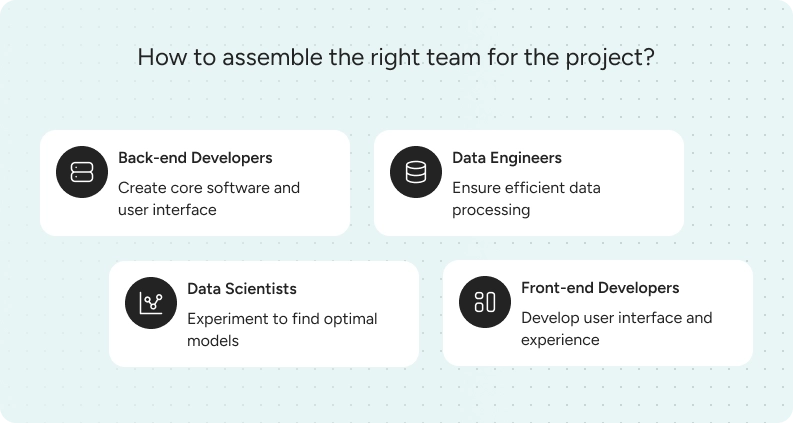Understanding the Problem
Before any coding begins, a team must understand the business problem they’re solving. It starts with asking the right questions. Analysts often lead this phase by engaging with clients through interviews or workshops. They aim to clarify the problem and gather information about available data. For instance, if a ski slope owner wants to distinguish between skiers and snowboarders, it’s essential to specify why this is needed, in what conditions, and with what data quality.
Without a clear understanding and good data, the best technology won't deliver useful solutions. So, the initial phase is all about refining the problem until it’s precisely defined.
Building the Right Team
Once the project is clearly defined, assembling the right team is crucial. Depending on the project's complexity, you could need a mix of back-end and front-end developers, data engineers, data scientists, machine learning engineers, and UX designers. Each plays a unique role:
- Back-end and front-end developers create the core software and user interface.
- Data engineers ensure the data is processed efficiently and correctly.
- Data scientists conduct multiple experiments to find the best models to solve the business problem.
- Machine Learning engineers integrate AI models with the main application.
- UX designers craft an intuitive interface to enhance user interaction.
- MLOps engineers scale systems to handle varying user loads and ensure that monitoring of the AI model is in place.
A project might start with a Proof of Concept (PoC) to test feasibility. If successful, it progresses to a Minimum Viable Product (MVP), where scalability and user testing become vital.

Learning from Real Examples
Let's look at a project aimed at counting orthopedic tools in a tray using a smartphone camera. Initially, the AI struggled because users were photographing the trays at odd angles, disrupting its accuracy – even after promising initial tests.
The solution was quite simple: add guide markers on the camera screen to help users align the phone correctly over the tray. This tweak significantly improved the system's performance, meeting the client's expectations and highlighting how user-friendly design can make or break a tech product.
This example underscores the importance of thoughtful design and user experience in AI projects. Understanding and accommodating user behavior can transform a complex solution into an effective and accessible tool.
The Role of Data
But AI isn't just about advanced algorithms. It’s about how data is used to solve specific problems. Any AI system is only as good as the data it processes. So, understanding the data's source, quality, and context is essential. This approach helps designers and developers choose the right technology and refine it to fit the project's needs.
Bridging Design and AI
A key takeaway for designers entering AI projects is to focus on data and user interaction. Designers should strive to make AI understandable and user-friendly to reduce the learning curve for end-users. Good design ensures that AI tools are not just technically proficient but also accessible and beneficial to the target audience.
Fostering Better Collaboration
Effective AI projects result from good team communication and understanding each other’s domains. Designers and technical teams, like data scientists and developers, should work closely from the start. This collaboration ensures that the business questions are accurately translated into technical solutions.
In the end, it's about creating a bridge between the technical requirements and the user's needs. This integration is where innovation happens, leading to software that meets both business goals and user expectations.
Developing AI-powered software is a collaborative effort that requires clear goals, the right expertise, and a focus on data quality. By understanding these elements, you can better appreciate this fascinating field and navigate it more effectively. Let's hope this spirit of collaboration continues to evolve, bringing more nuanced and effective AI solutions into our everyday lives.
For more inspiring insights on AI and UX design check out our dedicated blog series: AI for UX.









